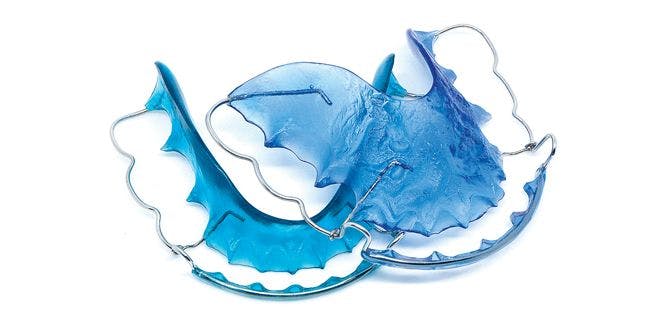Invisible teeth aligners have soared in popularity in recent years, especially for adults who don’t want to relive their metal-mouthed teen years. These and other plastic dental appliances such as retainers and night guards are discreet, but bacteria tend to grow in their nooks and crannies, especially as their surfaces get rougher from wear. Researchers […]

Invisible teeth aligners have soared in popularity in recent years, especially for adults who don’t want to relive their metal-mouthed teen years. These and other plastic dental appliances such as retainers and night guards are discreet, but bacteria tend to grow in their nooks and crannies, especially as their surfaces get rougher from wear. Researchers have now made a coating that protects these appliances from bacterial growth, while also making the devices’ plastic stronger.
Dentists prescribe these devices for different purposes: Retainers help hold teeth in their proper positions, night guards stop people from grinding their teeth while they sleep, and aligners slowly move teeth until they are straight, offering an alternative to traditional braces. “The adhesion of bacteria cannot be prevented, no matter how much you brush your appliances or use the recommended antibacterial solution,” says Jinkee Hong, a chemical and biomolecular engineer at Yonsei University. This bacterial buildup can cause bad odors and increase the chances of tooth decay and gum disease.
Medical implants such as artificial joints or pacemakers prevent bacterial growth using silver or titanium antibacterial coatings. Researchers have tested similar coatings for metallic dental implants that anchor false teeth. But these coatings are hard to apply to plastic.
Common oral bacteria grow profusely on a sheet made of polyethylene terephthalate (PET), used to make clear dental appliances (left, top and bottom). Meanwhile, very few bacteria stick to PET that has a sugar-based superhydrophilic coating (right, top and bottom).
Hong, Hyo-Wan Anh, and their colleagues wanted to make antibacterial films for plastics that would endure conditions in the mouth, which has a hodgepodge of enzymes and varying pH.The films would also need to be safe for oral use and made with easily available materials and simple synthesis methods. They chose to create a multilayer film made of two polysaccharides: chitosan, which is derived from crustacean shells, and carboxymethylcellulose, a common thickener used in food and pharmaceuticals.
They used an approach called layer-by-layer assembly, which consists of electrostatically depositing alternating layers of opposite charge onto a surface. They deposited five layers each of negatively charged carboxymethylcellulose and positively charged chitosan onto sheets of polyethylene terephthalate (PET), the transparent plastic used to make most dental devices. This resulted in a clear, 1.8-µm-thick coating. The carboxyl groups in carboxymethylcellulose and the amine groups in the chitosan are superhydrophilic: They attract water, creating an ultrathin, smooth water film on the plastic surface that keeps bacteria from sticking.
The researchers exposed coated and uncoated PET to the common oral bacteria Streptococcus mutans. After 24 hours, the coated sheet had 75% less bacterial growth than the uncoated sheet. The coating did not degrade or detach when immersed in artificial saliva solutions with varying acidity levels and enzymes. What’s more, the coated plastic was also slightly stronger and more fracture resistant than uncoated plastic.
Antibacterial coatings on clear dental devices haven’t been explored and are a good idea, says Conrado Aparicio, a dental biomaterials expert at the University of Minnesota. Recommended daily cleaning of aligners relies on patient compliance, and the difficulty of accessing some surfaces of the appliances makes a thorough cleaning difficult. The researchers will have to study whether the coating changes the appearance of dental devices after they are exposed to drinks and food for extended periods, Aparicio says. “The intrinsic porosity and hydrophilicity of the coating, although important for its antimicrobial characteristics, can also [retain] staining components from, for instance, coffee and mustard.”
